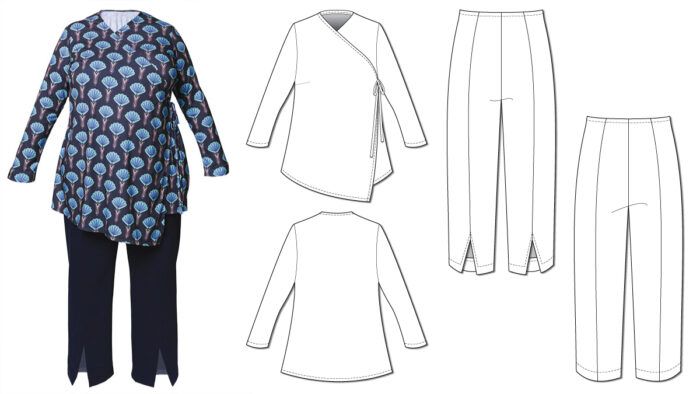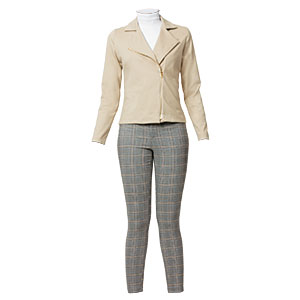Pattern Review: Christine Jonson PlusCJP Wrap Tunic 1215+ and PlusCJP Split Hem Pants 612+

Two Easy Pieces
Skill Level:
These beginner-friendly garments, designed for knits and are simple to sew.
Size Range and Fitting:
The tunic is sized LG to 4X for busts 44 inches to 64 inches, waists 37 inches to 57 inches, and hips 46 inches to 68 inches. The pants are sized 22 to 42 for waists 41 inches to 61 inches, and hips 50 inches to 72 inches.
Fabrics:
For the tunic, knits with spandex, such as rayon jersey, ITY, or stretch velvet. The pants require a substantial knit with at least 25 percent cross-grain stretch. Select a firm ponte di Roma or a double knit.
Style and Sewing Details:
The asymmetrical tunic has a generous fit. Its pointed hemline hangs 1-3/4 inches longer in front. It has full-length sleeves, bust darts, and a crossover front that ties at the waist at the left side seam, plus an interior tie at the right side seam. The in-seam pockets are cut in one with the front and back sections respectively, which eliminates some bulk at the hipline.
The straight-leg pants do not have side seams; instead the legs are shaped with contoured front and back seams. The front seam ends with a mitered vent. The waist is finished with 1/2-inch-wide elastic, aligned and sewn to the cut edge, then folded in and topstitched in place. The waist edge is intended to sit below the natural waistline.
 |
 |
- Important finished garment and body measurements are listed in easy-to-read grids, making it simple to compare measurements to find the ease amounts in different areas of the patterns.
- The instructions are mainly for a serger. If you do not have a serger, use a narrow zigzag stitch instead.
- Test sewing machine needles specifically for knits, such as ballpoint, stretch, or jersey. Choose the type that works best with your knit.
- The instructions advise using a French curve as a guide to draw the stitching line for the tunic’s side-seam pocket openings. The gentle curve ensures a smooth seam over the hip.
- The pants’ waistline seam, as well as the front and back leg seams, are contoured for a smooth transition over the hips and thighs.
This review was originally published in Threads #223, Fall 2023. Have you made this pattern? If so, be sure to share pictures in our Readers Closet gallery.
Photos: Jack Deutsch. Illustrations: Kelly Keenan.
































Log in or create an account to post a comment.
Sign up Log in